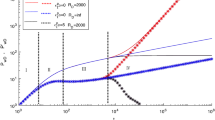Abstract—
The paper is devoted to the simulation of oil displacement by water and the formation of the Saffman–Taylor instability. The problem is solved in two-dimensional formulation. A circular domain with one injection well and eight production wells located along the contour around the injection well is considered as geometry. To study the patterns of oil displacement by water, hydrostatic pressure, oil and water seepage rates, and oil saturation are calculated. The graphical analysis considers mainly the oil saturation field. The hydrostatic pressure field is calculated by solving the steady-state piezoconductivity equation; the field of the oil-water seepage rate is calculated using the linear Darcy filtration law; and the oil saturation field is calculated from the solution of the advection transport equation. The two-phase nature of the flow considered in the problem lies in the fact that the oil and water phases have their own relative phase permeabilities calculated using the Brooks–Corey model. The equations are solved numerically using the finite volume method. An irregular triangular grid is used to discretize the computational domain. As a result of the simulation, it is established that the type of the Saffman–Taylor instability, due to its randomness, strongly depends on the computational grid. After the production wells are flooded, the displacement front stabilizes. The instability increases as the ratio of dynamic viscosities of oil and water increases.











Similar content being viewed by others
REFERENCES
A. A. Lipaev, Development of Heavy Oil Deposits and Natural Bitumen (Inst. Komp. Issled., Moscow–Izhevsk, 2013) [in Russian].
A. A. Korshak and A. M. Shammazov, Fundamentals of Oil and Gas Engineering (DizainPoligrafServis, Ufa, 2001) [in Russian].
P. G. Saffman and G. I. Taylor, “The penetration of a fluid into a porous medium or Hele-Shaw cell containing a more viscous liquid,” Proc. R. Soc. A 245 (1242), 312–329 (1958).
Q. Yuan, X. Zhou, J. Wang et al., “Control of viscous fingering and mixing in miscible displacements with time-dependent rates,” AIChE J. 65 (1), 360–371 (2019).
A. Mcdowell, S. J. Zarrouk, and R. Clarke, “Modeling viscous fingering during reinjection in geothermal reservoirs,” Geothermics 64, 220–234 (2016).
M. Mishra, M. Martin, and A. De Wit, “Miscible viscous fingering with linear adsorption on the porous matrix,” Phys. Fluids 19 (7), 073101, 073101-1–073101-9 (2007).
J. Moortgat, “Viscous and gravitational fingering in multiphase compositional and compressible flow,” Adv. Water Resour. 89, 53–66 (2016).
R. Maes, G. Rousseaux, B. Scheid et al., “Experimental study of dispersion and miscible viscous fingering of initially circular samples in Hele-Shaw cells,” Phys. Fluids 22 (12), 123104, 123104-1–123104-12 (2010).
A. V. Stepiko, Investigation of the Displacement of a Viscous Fluid in a Hele-Shaw Cell, in Probl. Geol. Osvoenie Nedr, Vol. II (Isd. Tomsk. Politekh. Univ., Tomsk, 2014) [in Russian].
Yu. V. Pakharukov, F. K. Shabiev, and R. F. Safargaliev, “Oil displacement from a porous medium with the aid of a graphite suspension,” Tech. Phys. Lett. 44 (2), 130–132 (2018).
O. A. Logvinov, “Stabilization factors of viscous fingering in an annular Hele-Shaw cell with a source,” Vestn. Kibern., No. 2, 147–153 (2016).
A. A. Kostina, M. S. Zhelnin, O. A. Plekhov, and I. A. Panteleev, “Investigation on the effectiveness of using analytical approaches to describe the evolution of a steam chamber during oil production by steam-assisted gravity drainage,” Geosist. Perekhodnykh Zon 3 (1), 54–64 (2019).
B. Jha, L. Gueto-Felgueroso, and R. Juanes, “Fluid mixing from viscous fingering,” Phys. Rev. Lett. 106 (19), 194502, 194502-1–194502-4 (2011).
N. N. Smirnov, V. V. Tyurenkova, A. B. Kiselev, and V. F. Nikitin, “Filtration flows in a porous medium,” Sev. Reg.: Nauka, Obraz., Kult., No. 2 (32), Part II, 74–86 (2015).
R. G. Shagiev, Well Survey by Pressure Build-Up Curves (Nauka, Moscow, 1998) [in Russian].
V. A. Korotenko, A. N. Sumin, and A. K. Yagafarov, “Piezoconductivity equations for two-phase filtration of oil and water,” Nauka TÉK, No. 2, 17–18 (2011).
M. Muskat, Physical Principles of Oil Production (McGraw-Hill, New York, 1949; Inst. Komp. Issled., Moscow–Izhevsk, 2004).
H. M. Nick and S. K. Matthäi, “Comparison of three FE-FV numerical schemes for single- and two-phase flow simulation of fractured porous media,” Transp. Porous Media 90 (2), 421–444 (2001).
K. Li and R. N. Horne, “Comparison of methods to calculate relative permeability from capillary pressure in consolidated water-wet porous media,” Water Resour. Res. 42 (6), W06405, 1–9 (2006).
F. Mokalled, L. Mangani, and M. Darwish, The Finite Volume Method in Computational Fluid Dynamics, Fluid Mechanics and Its Applications, Vol. 113 (Springer, Cham, 2016). https://doi.org/10.1007/978-3-319-16874-6
A. E. Krasnoshtein, B. P. Kazakov, and A. V. Shalimov, “Modeling complex air-gas-heat dynamic processes in a mine,” J. Min. Sci. 44 (6), 616–621 (2008).
Funding
This study was supported by the Council for Grants of the President of the Russian Federation under the scientific project no. MK-6244.2018.5.
Author information
Authors and Affiliations
Corresponding author
Additional information
Translated by I. Tselishcheva
Rights and permissions
About this article
Cite this article
Bublik, S.A., Semin, M.A. Study of the Saffman–Taylor Instability in an Oil Reservoir Formation in Two Dimensions. Math Models Comput Simul 13, 263–273 (2021). https://doi.org/10.1134/S2070048221020046
Received:
Revised:
Accepted:
Published:
Issue Date:
DOI: https://doi.org/10.1134/S2070048221020046




